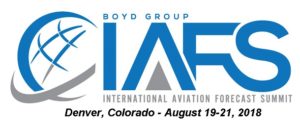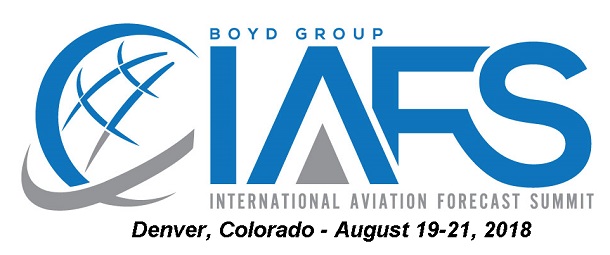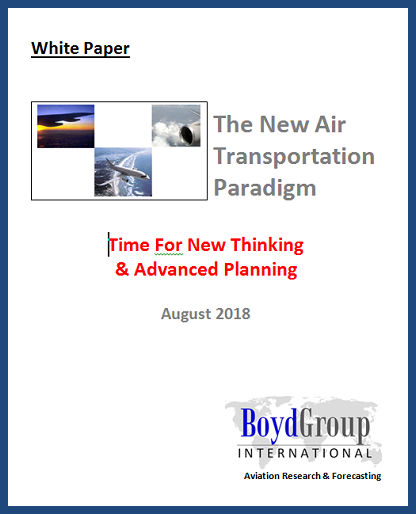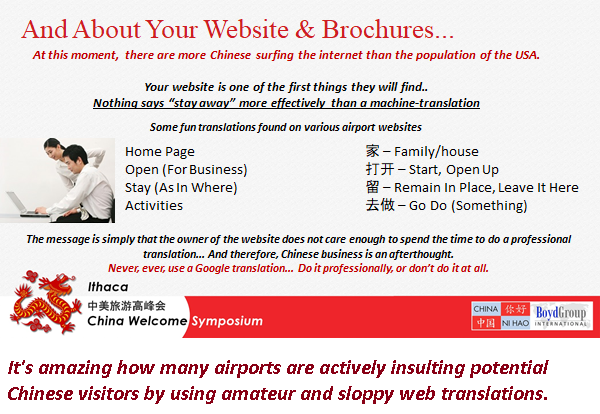Next Update On September 4, Recognizing The US Labor Day Holiday…
______________________
The #1 Aviation Event Delivers Again!
Just a Glance At A Few of The Highlights
The 23rd Boyd Group International Aviation Forecast Summit wrapped up right on time at 5PM, Tuesday August 21.
It capped four days of exciting events, presentations and discussion sessions. As always, the IASF™ had no pre-titled “panels” – instead, we got the views and perceptions directly from the leaders in the aviation industry.
The National And Industry Media Were At The Summit In Force. We were particularly excited this year to have media from all areas attending the Summit – CNBC, Bloomberg, The Wall Street Journal, Air Transport World, Airline Weekly, Dallas Morning News, Las Vegas Review-Journal, Access Intelligence, Avionics Magazine, Reuters, Flight Global, Skift, Travel Weekly, Cranky Flier, Airport Business – and a few free-lancers, too.
 Do a search – you’ll find that the content of the Summit has driven a lot of in-depth media stories.
Do a search – you’ll find that the content of the Summit has driven a lot of in-depth media stories.
Our First Aviation Leadership Award. We were excited to implement the first IAFS™ Aviation Leadership Award, given this year to Robert Fornaro, CEO of Spirit, for his long contributions to thought-leadership in the airline industry.
All The Way – Straight Talk. From The starting point of a lively issues discussion with A4A CEO Nick Callio (and, yes, the PFC issue was a hot Q&A subject item – no holds barred) down to the final session on Tuesday, which delivered the only solid research and forecasts of the China-US market.
China – Time For Facts And Hard Data. By the way, in that final Airports:China™ session, we outlined the top potential second-tier markets between China and the USA, and the US airports in line for such flights – with some surprising conclusions.
This session was preceded by an incisive reality session with Dr. Chi Zhi Hang, VP-North America of Air China, where the issues of open skies and JVs between US and Chinese airlines were outlined to be the first step before any “flights to China” can even be envisioned from secondary US airports.
Communication Is Now Instant. Logistics Are Lagging. One of the key forecast points illuminated in the Forecast Mapping Session, which opened the Summit, was that logistics will be the next huge disruptive force in the airport industry. While communication channels have gone in the last 200 years from traveling along with logistics – i.e. at the speed of a horse – to nearly instantaneous from sender to receiver, logistics are only marginally more advanced than 50 years ago.
This is where new channels of logistics will be coming into play in the next five years, including UAS (drone) technology that could completely change distribution systems. How this will affect airports across the nation remains to be seen, but it could signal an economic rebirth at rural facilities.
United – Our Platinum Sponsor. We were honored to have Scott Kirby, president of United Airlines (one of our Platinum Sponsors) at the Summit to talk about his carrier’s expansion plans, such as at Washington Dulles. In the free-form discussion format of the Summit, a lot of ground was covered – with no canned presentations.
Southwest – Platinum Sponsor & Hawaii Update. Andrew Watterson EVP and Chief Revenue Officer of Southwest delivered an in-depth review of the carrier’s careful and planned move into Hawaii, and in the Q&A discussed how new stations for Southwest in the US were going to be well down the timeline.
New Fleets – New Opportunities. One of the most incisive sessions was the Q&A with all of the major aircraft manufacturers, where the attendees queried these senior executives on the potential effects of new super-long-haul airliners, as well as the emergence of fleets that have entirely new mission capabilities.
Airport Enplanements – Strong Growth, But Redistributed. The Airports:USA® session forecasted a 25% growth in national enplanements through year 2017. This is equivalent to the passengers now using the top six US airports combined.
On the other hand, the session revealed that air travel is less attractive as a communication channel in short-haul “commuter” markets such as between the DFW Metroplex and the Austin-San Antonio-Houston triangle, where traffic has dropped by 50% since 2000.
In addition, the costs and consumer shifts in the past 20 years have shown that air is also no longer economically feasible between many small and mid-size intra-regional markets. Regardless of the number of “task forces” or “studies” – air transportation is less and less of a communication channel compared to 30 years ago.
Wildcatter Airlines – A Whole New Consumer Product. The Airports:USA® session also outlined how ULCCs are now using airliners to deliver a whole new consumer spend product. Like the wildcatters in the oil business, these carriers seek out pockets of discretionary revenues that can be drilled and captured by offering low-cost air transportation.
These wildcatters make market decisions that are often galaxies away from the methodologies used by traditional airlines in making market decisions. They are a wild card when forecasting traffic – they come, and if the market works, they stay. If not, they leave.
These are just the tip of the huge mountain of presentations and business intelligence delivered at the 2018 Boyd Group International Aviation Forecast Summit.
Presentations Available To Summit Attendees. Where the presenters allow, and where there were slide presentations, these will be made available to Summit attendees shortly, along with the BGI forecast sessions.
Thanks To All of Our Sponsors… And Denver International! We want to thank all of our sponsors, including Platinum Sponsors Southwest Airlines and United Airlines.
We are in awe of the support of our host, Denver International Airport, which pulled out all the stops to make this the biggest IAFS™ yet.
In addition to all of the other extensive support, including special gifts to all attendees that showcased the great city of Denver, the staff of DEN delivered hospitality that bespeaks the Mile High City. But in particular, the Monday night event at Coors Field was nothing short of incredible.
We want to thank Kim Day and her staff, whose planning, support an execution made this year’s Summit incredibly successful!
We want to thank all of our nearly 400 attendees – your presence and participation makes the Summit what it is.
Thanks To The BGI Team, Too! We also want to recognize our own staff. Marian Boyd – CEO, and her immediate team – Sonia Watts and Dan Cohn – are the #1 team in the industry. Their work is the reason that this is now an event that aviation leaders clear their calendars for every year.
This is the industry standard… the attention to detail, the quality of the content, the close relationships with industry leaders from across the world, and the Marine Corps-like focus on absolute perfection – are the reasons attendees tell us that the Summit is the best aviation event – better than any other.
Professionalism is the at the core of Boyd Group International, and the Summit is the proof. Thanks again to every one for making it happen.
 Plus, we’ll be issuing our new White Paper, The New Paradigms in Air Transportation, which is a document that will outline the material changes in how airlines – and consumers – will shape travel patterns.
Plus, we’ll be issuing our new White Paper, The New Paradigms in Air Transportation, which is a document that will outline the material changes in how airlines – and consumers – will shape travel patterns. Mr. Kirby joins CEOs and senior executives from air carriers across the market spectrum and across the globe who will be at the IAFS™ and helping us explore the future.
Mr. Kirby joins CEOs and senior executives from air carriers across the market spectrum and across the globe who will be at the IAFS™ and helping us explore the future. Blake Scholl and his team will be outlining the progress of the 55-seat, 2.2 Mach Boom airliner, as well as the one-third scale “Baby Boom” research and proof-of-concept aircraft that will fly in 2019.
Blake Scholl and his team will be outlining the progress of the 55-seat, 2.2 Mach Boom airliner, as well as the one-third scale “Baby Boom” research and proof-of-concept aircraft that will fly in 2019. The White Paper will compare the structural and fundamental changes in the air transportation industry, with the shifts that will be critical in airport and air service access planning.
The White Paper will compare the structural and fundamental changes in the air transportation industry, with the shifts that will be critical in airport and air service access planning.